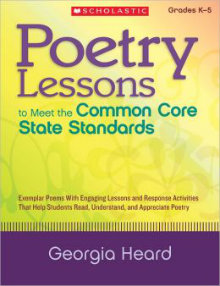A No-Angst Approach to Teaching Poetry
Poetry Lessons to Meet the Common Core State Standards:
Exemplar Poems With Engaging Lessons and Response Activities That Help Students Read, Understand, and Appreciate Poetry
By Georgia Heard
(Scholastic, 2012 – Learn more)

Poetry is imagination put to music. From the rhythmic rocking in the womb to the emergence of a child’s first contact with the singsong pattern of nursery rhymes. Our children have been blessed with the gift of what we call “the music of poetry.” Poetry is music and music is poetry.

Georgia Heard does it again
Georgia Heard, author of books to teach poetry such as Awakening the Heart: Exploring Poetry in Elementary and Middle School, For the Good of Earth and Sun: Teaching Poetry, and Climb Inside a Poem: Reading and Writing Poetry Across the Year, has done it again! I don’t know how she does it, but she does.
When you encounter her books about teaching poetry, each reads like a poem. It’s like savoring a delicious piece of cake. She entices you with anecdotes, sprinkles in research, and puts the icing on the top, guiding you into making the teaching of poetry exciting and meaningful.
Many adults compare reading and analyzing poetry to the scraping sound of fingernails on a chalkboard. (This analogy was obviously created before whiteboards!) It hurt the ears to think that we were going to read and discuss a poem ad infinitum.
However, as education changes, so do our mindsets. Teaching poetry using close reading strategies as outlined in Heard’s book for grades K-5 elevates poetry to where it should be – an art form. Heard’s close reading strategy lessons are exhilarating, develop higher order thinking, challenge middle level students in grades 4-5 (maybe grade 6 also) to analyze and evaluate without “tying the poem to a chair with rope and torture a confession out of it” (Billy Collins).
The pleasure and the craft of poetry
I happen to love cooking and I know that when you cook, you need to have a balance of flavors. Georgia Heard is the Julia Child of poetry. She cautions the teacher to make sure that they provide a balance with the poetry their students are able to access in the classroom – reading for pleasure but also exploring the craft and word study.
I love how she organizes the book by first describing how to create an environment for reading and writing poetry, then moving on to how to help students with reading comprehension through the various strategies. We know that time is never enough in our classrooms or when planning lessons. She provides the reader with demonstration lessons using and addressing the Common Core’s “text complexity” expectations. The book is complete with reproducible pages, a poetry website, sample student work, and a close reading lesson that reads like a poem.
Fully developed lessons and more
Heard eliminates the angst of finding lessons to effectively teach poetry. She is so thoughtful, citing standards used, as well as chapters and pages to find specific lessons. It’s like putting the cherry on top of an ice cream sundae. She even shares the correlation of the poems in the book to the CCSS standards.
I never thought I would want to “live with a poem for a week,” but with the close reading strategies I find in these lessons, I enjoy my partnership with poetry. Monday is for introducing the poem, Tuesday and Wednesday for guiding students to dig deeper into what the poems says, Thursday for discussing how the poem is built, and Friday for giving them a chance to put it all together.
Anchor Standards 4 and 5 are addressed with a weekly demonstration lesson plan for each poem and a research based explanation of the process. As I read each lesson, I felt and heard Ms. Heard (no pun intended) coaching me and guiding me.
I happen to love poetry. Poetry gives the writer a chance to experiment and play. It gives the student a chance to become a nonconformist in the world of language rules and regulations. It gives the child a chance to say, “What I feel counts!” Heard’s book inspires the poet in everyone.
Linda Biondi is a fourth grade teacher at Pond Road Middle School in Robbinsville, NJ, and a long-time Morning Meeting practitioner. She’s also the recipient of several educational grants, a Teacher Consultant with the National Writing Project and a participant on the NJ Department of Education Teacher Advisory Panel. Linda participates in ECET2 Celebrate Teaching which recently posted an interview with her.

































